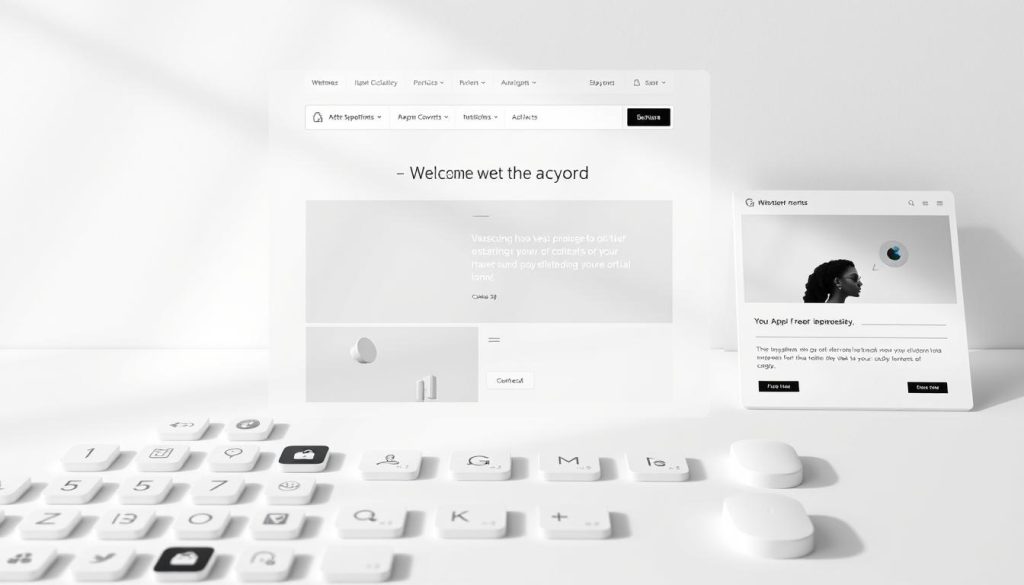In today’s digital world, having a strong online presence is key to success. Your website is like your virtual storefront. It’s where you showcase your brand and connect with people. Yet, even the best content can fail without a great design.
Your website’s design is critical: 75% of users judge a company’s credibility by its design. People want a personalized experience—71% expect it, and 76% get frustrated without it. Slow websites are a big turn-off. Sites that take over 3 seconds to load lose 90% of visitors. Those that load in 2 seconds see a 15% drop in bounce rates.
Key Takeaways
- 90% of businesses use content marketing to build their online presence.
- 75% of users judge credibility by website design quality.
- Websites with responsive design boost mobile traffic by 50%.
- Content marketing generates three times more leads than traditional ads.
- Slow websites lose 90% of visitors if they take over 3 seconds to load.
Understanding the Purpose of Your Website
Every successful website starts with a clear purpose. Your goals and audience shape how it functions and looks. Without a roadmap, your digital marketing efforts risk missing the mark. Let’s break down how to align your vision with results.
“A website without purpose is like a car without a steering wheel—it can move, but won’t reach its destination.”
Defining Your Website Goals and Objectives
Ask yourself: What actions do you want visitors to take? Common goals include:
- Selling products/services
- Generating email leads
- Building brand awareness
- Providing customer support
A fitness studio aiming to sell memberships might prioritize clear class schedules and signup forms. An e-commerce store selling handmade jewelry would focus on high-quality product images and secure checkout systems. A study shows websites with clear goals see conversion rate improvements of up to 200%.
| Goal Type | Example Metric | Strategy |
|---|---|---|
| Lead Generation | Conversion Rate | Optimized forms, pop-ups |
| Brand Awareness | Social Shares | Shareable content, infographics |
| Sales | Average Order Value | Discount codes, upsells |
Identifying Your Target Audience
Who are you trying to reach? Consider demographics, behaviors, and pain points. A bakery targeting busy parents will use different language than a luxury spa. Use tools like Google Analytics or surveys to uncover needs. Remember:
- 60% of consumers abandon sites that don’t meet expectations
- 80% of marketers say their digital marketing goals depend on audience-focused design
Setting Measurable Success Metrics
Track progress with concrete numbers. Examples:
- Conversion rate: How many visitors take desired actions?
- Engagement time: Are users staying on pages?
- Customer acquisition cost: What’s the ROI of your marketing spend?
Pair metrics with A/B testing. A 2023 study found websites using analytics improve retention by 40%. Your goals and audience data form the foundation for every design and content decision.
Essential Elements Every Successful Website Must Have
Creating a great website starts with key elements that focus on user experience. A messy layout or slow loading can scare off visitors. In fact, 75% of people judge a company’s trustworthiness by its design. Here are the must-haves to keep your visitors interested:
- Intuitive Navigation: Easy menus and clear labels help avoid confusion. Users should find important pages in 3 clicks or less.
- Clear Calls-to Action (CTA): 70% of small businesses miss out on sales by ignoring CTAs. Use phrases like “Shop Now” or “Download Guide” to guide visitors.
- Mobile Optimization: Google now favors responsive designs. Pages that take over 3 seconds to load lose 57% of mobile users.
- Trust Signals: Secure payment badges, contact info, and a privacy policy build trust. 94% of users notice design flaws right away.
- Engaging Content: Video content can increase conversion rates by 80%. FAQs can also reduce support inquiries by answering common questions upfront.
“A well-designed user experience turns visitors into loyal customers,” say 19 Forbes Business Council members. “Every element—from loading speed to CTAs—contributes to long-term success.”
| Element | Impact on Success |
|---|---|
| Navigation Structure | Increases engagement by 83% |
| Mobile Responsiveness | Reduces bounce rates by 40% |
| Clear CTAs | Boosts conversions by 200% |
| Video Content | Raises engagement by 94% |
Every detail, from speed to visuals, affects how visitors see your brand. Focus on simplicity, clarity, and ease of use. A website that gets these right builds trust, drives sales, and grows.
Selecting the Right Website Platform and Hosting
Your website’s success begins with the tools and infrastructure you pick. Choosing the right platform and hosting is key. Let’s explore how to make these choices with clarity.
Comparing CMS Options: WordPress, Wix, Squarespace and More
WordPress is a big name, powering over 40% of websites. It’s known for its flexibility and wide range of plugins. Wix and Squarespace are great for design, but might not let you customize as much.
Think about your skills and what you need for your content. Bloggers might like WordPress, while creatives might prefer Squarespace’s designs.
Over 40% of all websites run on WordPress, making it a top choice for content management.
Choosing a Domain Name That Resonates
Domain names are key to your brand’s online identity. Go for a .com if you can, keep it short, and avoid hyphens or numbers. For example, “yourbrand.com” is better than “your-brand123.com.”
A domain that’s easy to remember is a big plus for your web development strategy.
Understanding Hosting Requirements and Options
Hosting choices depend on your site’s traffic and budget. Shared hosting (like HostGator at $3.75/month) is good for small sites. For more traffic, consider VPS or cloud hosting.
Managed hosting, like WP Engine, offers security and backups. Look for providers with 99.9% uptime (e.g., A2 Hosting) and plans that grow with your site.
Compare options like:
- Shared hosting: Affordable for small businesses
- Cloud hosting: Scalable for traffic spikes
- Managed hosting: Ideal for complex web development needs
Check contracts for hidden fees and make sure providers offer 24/7 support. Start with something affordable and upgrade as your site grows.
Web Design Principles That Captivate Visitors
Good web design is more than looks—it’s a mix of beauty and function. Your site’s design affects how users feel and act. Let’s look at key principles that make visitors into customers.
- Visual Hierarchy: Use size, color, and placement to highlight important parts. Studies show a 47% better understanding of websites with clear visual hierarchy.
- Color Psychology: Pick colors that match your brand. Blue builds trust, while red encourages action.
- Whitespace: 85% of users like clean designs. Too much clutter can scare them off.
- Mobile Responsiveness: With 50% of visits coming from mobiles (2023 data), make sure your site works well on all devices.
| Design Element | Impact | Example |
|---|---|---|
| Micro-interactions | 30% engagement boost | Button hover effects |
| Fast load times | 32% higher conversions | Optimize images under 100KB |
| Minimalist layouts | 40% lower bounce rates | Clear navigation menus |
Start with a clear message in the website’s top section. Use tools like Hotjar to see how users move. Make your site easy to use, like with good contrast, to reach more people. Also, get your web development team on board early to save on redesigns.
Creating Content That Converts Visitors to Customers
Your website’s content is key to turning visitors into customers. High-quality content attracts website traffic and builds loyal customers. Start with headlines that grab attention—use action verbs and address problems directly. For instance, “5 Steps to Boost Your Website Traffic Today” is more effective than vague titles.
Good copywriting is clear and urgent. Use short paragraphs, bullet points, and bold CTAs to guide readers. This can be signing up for a newsletter or buying something. Data shows 80% of users prefer skimmable content. Add visuals that support your message:
| Content Type | Purpose | Conversion Boost |
|---|---|---|
| Infographics | Show data trends | 45% |
| Video tutorials | Demystify complex processes | 60% |
| Case studies | Build trust | 55% |
Having a consistent content strategy boosts your authority. Blog weekly on topics your audience finds valuable. This builds trust and increases website traffic. Use A/B testing to improve headlines and CTAs, which can boost conversions by up to 300%. Also, 70% of consumers prefer learning about brands through articles, not ads.
First, focus on solving your audience’s problems. When your content educates and entertains, conversions will naturally follow.
SEO Optimization Strategies for Your Website
SEO optimization helps your website show up higher in search results. Let’s look at ways to increase visibility, draw more traffic, and expand your online presence. Begin by checking your site’s structure to remove duplicate content or slow pages that hurt rankings.

Start with on-page SEO by researching keywords that match what users are looking for. Use tools like Google Keyword Planner to find these phrases. Then, make sure your titles, headers, and metadata include your main keywords. For instance, a pest control company saw a 15% traffic rise by focusing on specific terms like “bed bug treatment near me.”
“One stronger page versus many smaller pages” – Google’s preference for focused, high-quality content.
Technical SEO involves three main steps:
- Boost mobile speed: Slow sites face penalties after Google’s 2020 speed update
- Use structured data markup to highlight important details like prices and reviews
- Fix broken links and use clean URL structures (like /blog/post-title instead of long parameters)
| Tactic | Impact | Example |
|---|---|---|
| Content Pruning | Boosts rankings | An e-commerce site gained 31% traffic after deleting 11,000 redundant pages |
| Featured Snippet Targeting | Increases CTR | SEMrush’s study showed 30% of top results use question-based titles |
| Local Citations | Drives local traffic | Proven.com’s zombie page cleanup generated 88% more organic visits |
Backlinks are key—Stone Temple found top results have 77% more backlinks than average pages. Create content that people want to share, like the viral voice search study that got 5.6k backlinks. For local businesses, verify your Google Business Profile and claim all directory listings to boost local search visibility.
Enhancing User Experience Through Mobile Responsive Design
Mobile devices account for over 54% of global website traffic. This makes mobile responsive design key for your website. A mobile responsive design makes your site work well on any screen size. It boosts usability and cuts bounce rates by up to 30%.
Users want quick access. 94% judge a site by its design, and 57% leave if it takes more than 3 seconds to load.
“60% of users avoid returning to non-mobile-friendly sites,” warns Google’s 2023 data. Responsive design isn’t optional—it’s a retention tool.
The main perks of mobile responsive design are:
- 160% higher conversion rates for optimized sites
- Better Core Web Vitals and faster load times
- Unified branding on all devices
| Responsive Sites | Non-Responsive Sites |
|---|---|
| 75%+ user trust | Higher bounce rates |
| 11x more mobile visits | Risk of losing 87% of possible customers |
| Google ranking boosts | Poor search visibility |
Make touch targets big, use fluid layouts, and focus on page speed. Google’s Mobile-Friendly Test and PageSpeed Insights can spot problems. Use adaptive images, lazy loading, and minimal JavaScript for better performance.
With 70% of mobile searches leading to immediate actions, your website must offer smooth experiences on all devices. Or, you might lose 69% of user interest to your competitors.
Marketing Your Website to Drive Qualified Traffic
Marketing your website is essential to turn visitors into customers. Over 61% of marketers face challenges in getting website traffic and leads. But, with smart digital marketing, you can overcome these hurdles. Your aim is to draw in visitors who are likely to buy or engage with your content.

“Effective blog headlines can drive 500% more traffic.” – SEO Best Practices
Begin by using social media. Share your blog posts, promotions, and behind-the-scenes content to direct followers to your website. Choose platforms like LinkedIn for B2B audiences or Instagram for visual brands. Regular posting builds trust and creates a loop of traffic between your site and social channels.
- Post high-quality content weekly to keep followers engaged.
- Use platform-specific tools like Pinterest boards or Twitter threads to link back to your site.
Email marketing can turn subscribers into loyal customers. Build your list by giving away free guides or discounts. Automated emails can nurture leads, like follow-up messages after a purchase or reminders for abandoned carts. One business saw over 4,000 website visits in days thanks to email campaigns.
Paid ads can bring quick results. Use platforms like Google Ads or Meta ads to target users searching for your products. Test different ad copies and track conversions to improve your campaigns. Spend your budget on the most effective channels.
Keep an eye on metrics like click-through rates and conversion rates to gauge your success. Focus on quality over quantity, ensuring every visitor fits your target audience. A blend of organic and paid strategies will help you maintain a steady flow of qualified website traffic.
Conclusion: Turning Your Website Into a Valuable Business Asset
Your website is more than just a digital space. It’s a key part of your business’s future. Keeping it updated and secure is vital. Over 25 years, successful businesses have seen their websites grow from simple listings to powerful tools that drive revenue.
Make sure to have a maintenance plan in place. This should include regular backups and software updates. This ensures your website stays reliable.
Creating new content is also important. Companies that update their blogs 11+ times a month get four times more leads than those who don’t. Use tools like Google Analytics GA4 to track how users interact with your site. This helps you make your site better.
A well-designed site can also boost sales. Sites with clear calls to action and easy checkout processes can cut cart abandonment by 20-30%. This means more sales for you.
Think of your website as an investment. Businesses that treat it as an asset see higher sales. With e-commerce reaching over $2 trillion a year, optimizing your online presence is key. Use SEO and social media ads to drive traffic and get more conversions.
Targeted ads can increase visits by 200%. Dedicated landing pages can improve lead capture by 300%. Stay ahead by using the latest trends like AI-driven analytics and mobile-first design.
Remember, a strong online presence is not set in stone. It needs to be adaptable. Focus on user experience and make decisions based on data. When done right, your website can become a self-sustaining engine for growth. It turns visitors into loyal customers and partners.


